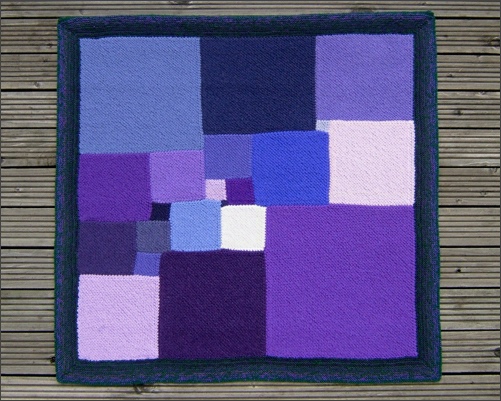




In our garment design we had our own set of rules to work to. Basically these were that everything should be in garter stitch (because it can make mathematically accurate shapes) and that all angles should be 45, 90 or 135 degrees (because these happen automatically in garter stitch by decreasing, knitting straight, or increasing) Every design had to have at least one square, knitted diagonally, from which all other calculations could be made.
We read a lot of Maths textbooks. That’s not strictly true because usually it was a matter of flicking through for diagrams that would fit our rules. The oft repeated phrase ‘I could knit that’ came from looking through some very boring textbooks. One book, in particular had a lot to offer. The far from boring Curious and Interesting Geometry had many line drawings to inspire us. It was written by David Wells and illustrated by John Sharp. One sees the name of an author on the cover of a book but when the name of the illustrator only appears on an inside page it doesn’t have the same impact. It was some years later that we realised that the illustrator and a man who was to have a great deal of influence on us were one and the same person.
The idea for Square Deal came from this book. It is all squares so fitted the rules very well. 21 different small squares make up the large square. This is the smallest number of different squares which can make a larger square. The arrangement was discovered in 1978 by A.J.W.Duijvestijn. Since 1939 it had been thought that 55 was the smallest number.
We used this in a way Duijvestijn. would never have imagined. Very little calculation was necessary to knit the squares. The sizes given in the book were doubled and taken to be the number of stitches needed on the diagonals of the squares. Doubling everything does not change the proportions so the pieces still fit together in the same way.
The finished piece was less than one metre square. The squares were made in shades of blue and, when it was finished, Square Deal was stapled to a wooden board which had been covered in navy blue fabric. This found a home in my classroom. It provided a nice exercise in arithmetic when pupils were told the sizes of some of the squares and had to find the measurements of the others. They worked in centimetres, I worked in numbers of stitches (or, in this case, multiples of numbers of stitches) but the maths was just the same.
We eventually made a second, purple, version. The reasons for this will be explained in the Penrose story.
